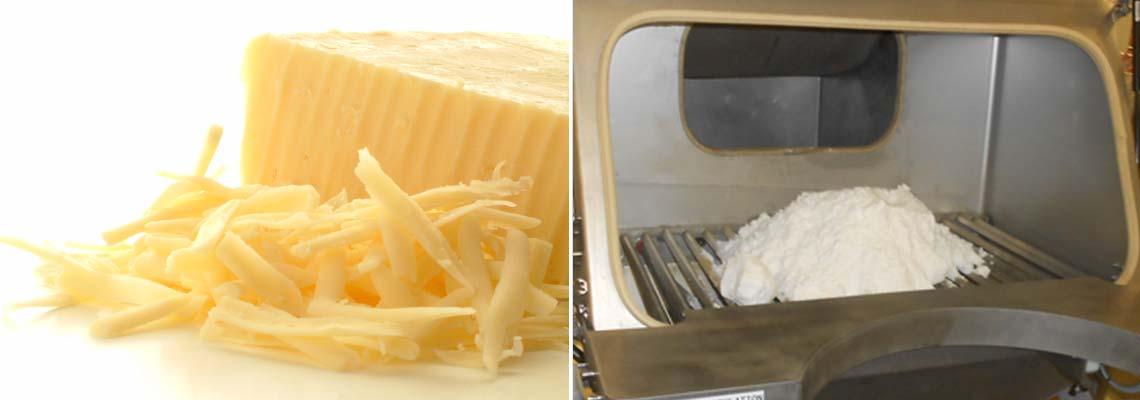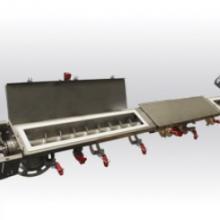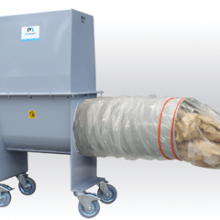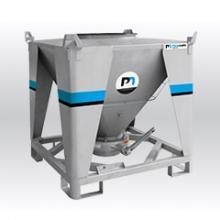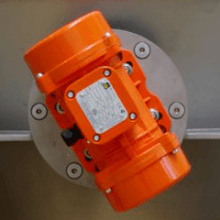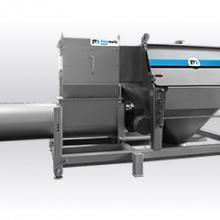Our client, located in rural Pennsylvania, USA, is a regional distributor of cheese, yogurt and flavored dairy products. The client received daily deliveries of liquid milk by tanker trucks via a liquid pump line into their primary storage vessels. While the milk was being pumped into their process, operators would hand add 50 lbs. sacks of non-fat or low-fat milk powder used to thicken the solution for the production of yogurts and cheeses. This manual powder feeding method created several problems. First, it was very manually intensive as operators had to manually unload 75 bags in 30 minutes. This created a lot of spillage and product loss. Second, with an open-air intake funnel directly into the liquid pump line, air would be sucked into the milk conveying line causing foam and other sanitary concerns. The mixture of the air with the liquid milk caused a lot of froth in the dairy storage tanks which would lead to longer clean down times after production. The cleaning method was to spray down the equipment with a hose.
The Palamatic Process solution:
Our sales team developed a turnkey industrial equipment solution to provide better ergonomics for the sack unloading operation, as well as significantly minimize the amount of air that was being introduced into the milk pump line. By integrating a semi-automatic bag dump station with trough-style screw conveyor and stainless-steel IBC storage vessels, the goal of feeding dairy powders in a less labor-intensive manner was achieved. The equipment was provided with CIP washdown capability to respect the sanitary requirements of the dairy production process.
The Equipment:
1. ERGOTIP® - Semi-automated sack tip tray
2. Trough Screw Conveyor
3. Stainless Steel IBC Storage
4. NEMA 4X Control Panel
1. ERGOTIP® - semi-automated sack tip tray
At the center of the industrial equipment system is the semi-automatic bag dump station called the “Ergotip®”. This powder handling station is designed to provide safe and ergonomic bag unloading for operators with the added benefit of increased production capabilities. An articulated serrated cutting blade is integrated below the safety grid of the powder feed station. For safety, the cutting blade can only be actuated with a two-handed push-button control located underneath the sack tray. The pneumatic cylinder forcefully swings the blade, providing a clean cut on the bottom side of the sack. The operator then only needs to fold the bag upward in half to allow the bulk material to pour out. Other integrated features include a built-in dust collection unit, bag compactor and CIP (clean in place) nozzles for 360° spray cleaning.
The integrated dust filter provides full capture of any free-floating particulates to keep the work area clean and healthy. Attached to the outside of the mini bag house is a compressed air tank. This equipment provides a reverse jet pulse cleaning service to keep the filter cartridges clean and help reclaim any loss of material from the filter. Furthermore, the housing of the filter cartridge was designed to be quickly disconnected for the clean in place procedures. By designing a quick clamp hinged access door on the side of the dust filter, the operator could easily remove the filter cartridge for clean in place procedures. It is important to keep the filter from getting wet to prevent any microbial growth on the cartridge.
The bag compactor allows the operator to dispose of the bag waste material through a side hatch on the bag dump housing. The emptied bag is pushed with force via an auger into a compaction tube. The tube is fitted with a plastic liner sleeve held on by elastomer tension rings. As empty sacks build up in the tube chamber they push the sleeve outward. This method allows for a reduction in the volume of waste material in a completely contained manner.
2. Trough Screw Conveyor
In order to transfer the milk powders from the bulk bag unloading station to the IBC storage units, a trough screw conveyor was integrated into the outlet of the bag dump station. The reason for using a trough-style auger housing was to help facilitate cleaning of the screw flights without the need for removing it from the housing. By utilizing hinged access doors along the top of the mechanical conveyor, the operator was able to fully wash down the internal contact surfaces of the conveyor. A tapping was installed at the bottom of the powder conveying unit to allow the excess powder and cleaning solution to be drained. The length of the conveyor was 10 feet long with a 6” diameter and 30° incline for a throughput rate of 125 lbs/min. All contact area were made of 304 stainless steel.
3. Stainless Steel IBC Storage
In order to prevent air mixing with the liquid pump line during the feeding of the milk powders, our team utilized stainless steel IBC vessels that could clamp to the feed port of the conveying line. By filling the sanitary tote unit prior to the milk being delivered, the operator only needed to disconnect the feed inlet from the screw conveyor via a tri-clamp connection, move the IBC to the powder feeding area via mobile forklift skid and dock the unit on the unloading support structure. The IBC support structure also incorporated vibrating motors with integrated spring coils to help shake the IBC and promote full discharge of the milk powder contents. The outlet of the IBC would easily dock to a radial seal and connection stub, made of food-grade elastomer. This allowed for an easy connection of the IBC outlet with the discharge spout on the support structure. The operator would then open the 2” sanitary butterfly valve to release the dairy powder. By feeding the powder in this manner, no air was introduced into the liquid line which prevented any foam from forming in the day tank downstream. The IBC’s were made of 304 stainless steel and had a capacity of 1300 liters.
4. NEMA 4x Control Panel
In order to provide control over the powder auger, dust filter, bag compactor, signal lights and safety switches, Palamatic Process provided a NEMA 4X control panel for the installation with our Pal’Touch HMI control system. The NEMA 4x was specified by our client so they could wash down the panel with a mildly corrosive cleaning solution. Palamatic Process designs, assembles and programs all controls panels in-house. Our team of automation engineers include user friendly raw material inputs, lot traceability, operator identification and dosing reliability. The PLC handles and controls the bulk bag discharge, loss-in-weight dosing management, conveying, dust collection, feeding and hopper selection. Further advantages include our Pal’Assist service for remote connection diagnostics. By integrating an ethernet remote maintenance box, our maintenance team can connect remotely and diagnose any issues within the control panel programming. Our technicians are also available for on-site commissioning and training support.
Palamatic Process has been supplying the powder and bulk solids industry with bulk bag handling equipment since 1992. In order to determine what solution is best for your project, contact one of our sales engineers. Together, our team of experts can provide the right kind of powder filling equipment that will fulfil your production goals.
Contact one of our experts today for assistance with needed material handling solutions and to request a quote.














